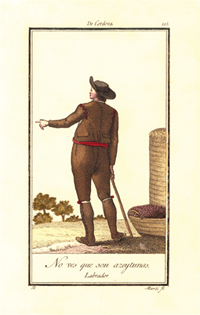
The voyages of discovery and mercantilism
1.500 A.D. THE VOYAGES OF DISCOVERY AND MERCANTILISM
THE NEW WORLD ENTERS THE SCENE28 years after the discovery of America by Christopher Columbus, the first olive tree saplings were shipped to the New World. In the middle of the XVI century, Argentina, Chile, California and Peru already possessed olive tree plantations, brought from Mexico, where they had initially been planted.

OLIVE OIL BEGINS TO FLOW FROM THE COUNTRYSIDE
Between the XV and XVI centuries, the cities of Luca, Siena and Florence, in Italy, began more significant cultivation of olive trees. It is said that the families with guaranteed incomes started to have a small olive tree plantation on their own lands, so as to ensure provision for their domestic consumption. It was no surprise that some of these families evolved from domestic production to larger scale cultivation, generating a surplus that increased their family income.
During the Middle Ages, olive oil was used as a component of soap, in the fabrication of cloth, production of rose, violet and bay leaf olive oils, the illumination of religious temples, in liturgical works, and, finally, as already mentioned above, in an irregular manner, in food. Animal fat and several other vegetable oils were always used more often than olive oil, as it was considered a less fine fat. On the other hand, the Jews and Moors always preferred olive oil in their food. After all the ups and downs over the centuries, one can deduce that mediaeval agriculture allowed the land to enjoy a long fallow period between the strong pressure during the Punic and Roman periods and the relentless competition that would begin in modernity and reach its peak today.
Moreover, according to Leo Hubermam, of the 22 million peasants in France around 1700, only 1 million were serfs in the traditional sense. The others had risen up the scale from servitude to complete frredom...little by little, the peasant landowners were acquiring the right to buy and sell without restriction, regulation or contention. Capitalism gained definitive lines and offered conditions for unrestricted exploitation of the land. Improvements were being introduced in agriculture such that the old, obsolete system of three fields, where one would always be left fallow, was abolished, constituting a real agricultural revolution. The result came in the form of a greater, more diverse supply of produce that was healthier, richer and more nutritious. However, it raises the question: Where did olive oil fit into all this revolution.
Some facts can sum up the implications of the end of the Mediaeval Times for the cultivation of olive oil: the incessant demand for food, the end of the feudal system, occupation of land hitherto relegated to abandonment, the development of mercantilism and industrialization, and, finally, the inexorable advance of scientific research, which gradually began the process of proving the organic benefits olive oil had been providing over the millennia.
During the Middle Ages, olive oil was used as a component of soap, in the fabrication of cloth, production of rose, violet and bay leaf olive oils, the illumination of religious temples, in liturgical works, and, finally, as already mentioned above, in an irregular manner, in food. Animal fat and several other vegetable oils were always used more often than olive oil, as it was considered a less fine fat. On the other hand, the Jews and Moors always preferred olive oil in their food. After all the ups and downs over the centuries, one can deduce that mediaeval agriculture allowed the land to enjoy a long fallow period between the strong pressure during the Punic and Roman periods and the relentless competition that would begin in modernity and reach its peak today.
Moreover, according to Leo Hubermam, of the 22 million peasants in France around 1700, only 1 million were serfs in the traditional sense. The others had risen up the scale from servitude to complete frredom...little by little, the peasant landowners were acquiring the right to buy and sell without restriction, regulation or contention. Capitalism gained definitive lines and offered conditions for unrestricted exploitation of the land. Improvements were being introduced in agriculture such that the old, obsolete system of three fields, where one would always be left fallow, was abolished, constituting a real agricultural revolution. The result came in the form of a greater, more diverse supply of produce that was healthier, richer and more nutritious. However, it raises the question: Where did olive oil fit into all this revolution.
Some facts can sum up the implications of the end of the Mediaeval Times for the cultivation of olive oil: the incessant demand for food, the end of the feudal system, occupation of land hitherto relegated to abandonment, the development of mercantilism and industrialization, and, finally, the inexorable advance of scientific research, which gradually began the process of proving the organic benefits olive oil had been providing over the millennia.
